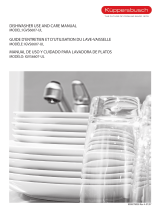
3
Noise Reduction System: A two-pump motor system,
the Suspension Motor TM, and triple insulation make this
dishwasher one of the quietest in North America.
Dishwasher Features
Stainless Steel TalITub: A rust-free, hygienic interior sur-
face with a lifetime warranty.
Nylon Coated Racks: Eliminate cuts and nicks, and have a
five year warranty.
Flow-Through HeaterTM: Heats water up to a sanitizing
temperature.
SaniDry TM Condensation Drying: A high temperature
final rinse, a low temperature stainless steel tub, and the
sheeting action of a rinse agent result in drying that is
hygienic, energy efficient, and economical.
EcoSense TM Wash Management System: Checks water
condition and decides whether a second fresh water fill
is necessary.
Triple Filtration System: Multiple filters ensure
distribution of clean water and protect the main pump
and the drain pump from foreign material.
Water Shut=Off: A safety feature that stops the flow of
incoming water, if water is detected in the base of the
dishwasher.
*Delay Start : This option allows you to delay the start
time of your dishwasher.
*Upper & Lower Rack Flip Tines : Increase the rack
flexibility to accommodate larger/taller items.
*Half Load: Reduces the energy and water consumption
when washing small, lightly soiled loads.
*Top Rack Only: Allows you to wash a small load of items
(in the top rack only).
*Extra Dry Heat: Raises the temperature of the rinse
water and increases the drying time which will result in
improved drying.
*OptiDry TM : This feature senses when the unit is low on
rinse agent and automatically increases the drying time.
*RackMatic TM Adjustable Rack Height: The top rack can
be raised or lowered to accommodate tall items in the top
and bottom racks.
*Manual Adjustable Upper Rack: You can raise or lower
the rack by removing and reinserting it at a different
level.
Dishware Materials
NOTE: Before using your dishwasher for the first time,
check the information in this section. Some items are not
dishwasher safe and should be hand washed; others require
special loading.
Recommended
Aluminum: Colored anodized aluminum may fade over
time. Minerals in your water may cause the aluminum to
darken or spot.This can usually be removed with a soap-
filled steel wool pad.
China, Crystal, Stoneware: Some hand-painted utensils
may discolor, fade, or spot. Hand-wash these utensils.
Position fragile glassware so that it will not topple over
or come in contact with other utensils during the wash
cycle.
Glass: Milk glass may discolor or become yellow.
Non-stick Coatings: Apply a light coating of vegetable oil
to non-stick surfaces after drying.
Plastics: Make sure the plastic ware is dishwasher safe.
Stainless Steel, Sterling Silver, and Silver Plates: Load
these utensils in a way that they do not come in contact
with other metals.
Not Recommended
Acrylic: Crazing (small cracks throughout the acrylic) may
occur.
Adhesive=Joined Pieces: Adhesives that join materials
such as plastic, wood, bone, steel copper, tin, etc. may
loosen.
Bone-Handled Utensils: Handles may separate.
Iron: Iron will rust. Hand-wash and dry immediately.
Non-Dishware Items: Your dishwasher is intended for
use in cleaning ONLY standard household dishware and
kitchenware.
Pewter, Brass, Bronze: Pewter will tarnish. Hand-wash
and dry immediately.
Tin: Tin will stain. Hand-wash and dry immediately.
Wood: Wooden bowls, wooden utensils, and utensils with
wooden handles can crack, warp, and lose their finish.
7




















